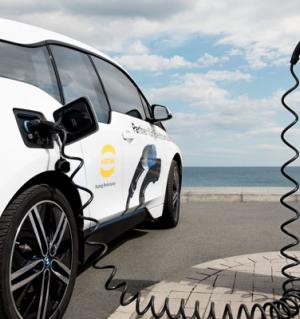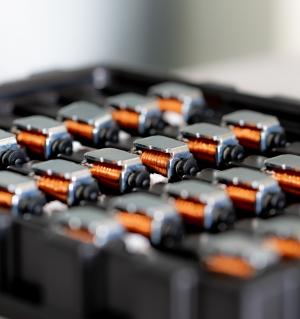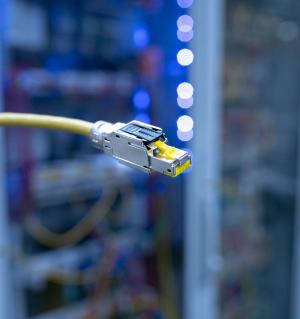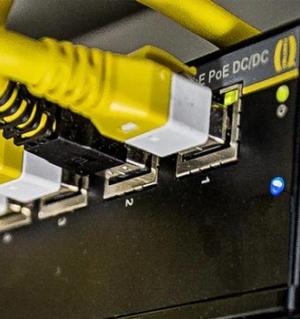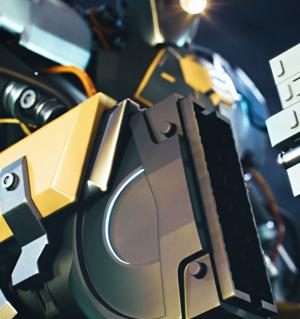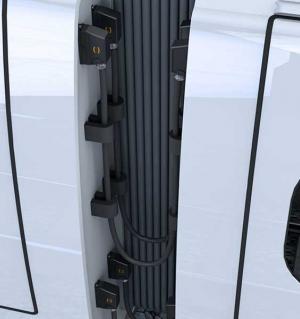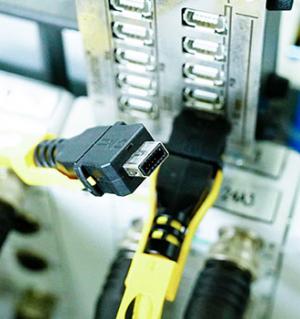Products & Solutions
M8 and M12 circular connectors
HARTING offers a comprehensive range of circular connectors in all common sizes and codings.
As one of the largest manufacturers of industrial connection technology, HARTING offers a comprehensive portfolio of circular connectors in all common sizes and codings. The product range includes field-terminable circular connectors, overmoulded cable assemblies as well as PCB connectors and panel feed throughs.
M8
- Typical application: Signal / Ethernet connections for sensors & actuators
- Coding A, D, P
- 3 - 8 poles
- Han® PushPull locking system
At the field level, M8 circular connectors are typically used for I/O boxes and other space-saving devices. Their compact size makes them the ideal connector when transmitting signals and data in demanding IP65/67 environments.
M12
- Typical applications
- Signals (A, B coding), 2 – 12 poles
- Data (D, X coding), 4 and 8 poles
- Power (L, S, K coding) 3 and 4 poles + FE/PE, up to 16 A / 630 V
- Hybrid (Y coding) 4 + 4 poles for data and power
M12 circular connectors are one of the most widely used sizes for circular connectors. The M12 size is available in coding variants for all industrial lifelines – for power, signals and data. IP65/67 protected and packaged in a rugged metal housing, they provide a completely reliable connection when used in demanding applications.
M23
- Typical applications
- Signals 6-19 poles
- Capacity 6 – 9 poles
- Hybrid
- Screw locking and bayonet rapid locking system (ComLock)
M23 circular connectors are used in industrial applications when high power must be transmitted or many signal contacts must be bundled. They are typically used for drives.
7/8“
- Typical applications: Power supply for drives
- 2 - 5 poles
7/8" is a typical interface for connecting power supplies to diverse applications.
Han® F+B connectors for the food industry
- Typical applications: Machines & Aggregates in food production
- Easy-to-clean design especially for the spray zone
- Food and beverage industry
The Han F+B is a circular connector designed to meet the special challenges of the food industry. The connection features extra protection against water jets from cleaning equipment and resistance to cleaning agents.
HARAX panel feed through
- Typical application: Low costpower connection for lamps, drives, devices etc.
- Easy and tool-free installation with HARAX® termination technique
- Thanks to IP67 suitable for use in outdoor and humid areas
The HARAX panel feed through can be connected without tools. The panel feed through can be installed quickly and easily, thus establishing a reliable device connection.
A-coded
- Typical application: Signal / Ethernet connections for sensors actuators
- Sizes M8 (IEC 61076-2-104) and M12 (IEC 61076-2-101)
- Rated current 1.5 – 7.5 A
- Rated voltage 30 - 250 V
- Number of contacts 3 - 12
The A-coding in 3 – 5 poles is used for the power supply of field devices. The 8 –12 pole A-coding is a typical coding for transmitting signals.
B-coded
- Typical application: Data transmission for fieldbus systems (PROFIBUS)
- Size M12 (IEC 61076-2-101)
- 2, 4 and 5 poles
The B-coding is used for PROFIBUS transmissions.
D-coded
- Typical application: Data transmission for fieldbus systems (PROFIBUS)
- Size M12 (IEC 61076-2-101), M8 (IEC 61076-2-114)
- Data rate <100 Mbit/s
D-coding is used in circular connectors for transmitting data for Industrial Ethernet applications. D-coding is specified for data rates up to 100Mbit/s Fast Ethernet.
K-coded
- Typical application: Power transmission of small drives
- Size M12 (IEC 61076-2-111)
- Electricity / voltage 12 A / 630 V
- 4 poles + PE
K-coding is one of the codings used for transmitting power. M12 circular connectors in K-coding are typically used for drives up to 7.5 kW. M12 Power is a space-saving solution that can be used to supply power to other devices.
L-coded
- Typical application: Power transmission of small drives
- Size M12 (IEC 61076-2-111)
- 4 poles + FE
- Rated current up to 16 A
The L-coding is used for supplying power to devices. Compared to K-coding, it has a FE contact and is designed for a different voltage range.
P-coded
- Typical applications: Power supply for drives
- Size M8 (IEC 61076-2-114)
- 4 poles
- Rated current: 4 A / 60 V
- 100 Mbit/s
The P-coding is used for transmitting data in EtherCAT P protocols. It manages to simultaneously supply data and voltages up to 240 W.
S-coded
- Typical application: Power connector for smaller devices
- Size M12 (IEC 61076-2-111)
- 3 poles + PE
- Electricity / voltage 12 A / 630 V
The S-coding is used for supplying power to devices.
Y-coded
- Typical application: Hybrid transmission of signals and power in one connector
- Size M12 (IEC 61076-2-113)
- 8 poles (Type 4)
- 4 x power: 6 A, 50 V
- 4 x data: Kat. 5, .5 A, 50 V
Y-coding has a hybrid mating face. It simultaneously supplies devices with both essential lifelines of power and data. The four data contacts enable transmission rates of up to 100 Mbit/s Fast Ethernet. The four power contacts transmit power of up to 300 W. Hybrid connections, such as Y-coding, can simultaneous supply multiple lifelines. This avoids using separate interfaces, saves resources and actively supports the miniaturization of devices.
X-coded
- Typical application: Data interface for Industrial Ethernet networks
- Size M12 (IEC 61076-2-109)
- Data rate 1; 2.5; 10 Gbit/s
- 8 poles
X-coding is used for transmitting Industrial Ethernet in demanding environments. With its excellent shielding, this coding enables transmission rates of up to 10 Gbit/s. Data streams are well protected from electromagnetic influences by the robust metal housing.
Crimp termination
In crimping terminations, a wire is enclosed in a gas-tight manner within the crimp contact by controlled deformation with crimping pliers or hydraulic/pneumatic crimping tools. This technique virtually produces a cold weld, thus ensuring the optimum resistance to ageing and mechanical stress from shock and vibration.
preLink® insulation displacement terminal
preLink® is based on insulation displacement technique and is used for data connectors up to 10 Gigabit/s. The wires are fed into a cube-shaped termination block and crimped/contacted and shortened in one operation using assembly pliers. This termination block can be clipped into M12 circular connectors as well as matching RJ45 connectors, cable couplings or PCB sockets. The mating face can be changed in seconds at any time.
Reflow soldering termination (THR)
With THR (Through Hole Reflow) soldering technology, the connector is inserted into through-plated PCB holes. This can be done automatically with PickPlace placement machines. These THR components are then soldered together with the components placed on the surface as part of a common reflow soldering process.
Reflow temination (SMT)
SMT (Surface Mounted Technology) connectors, in contrast to through-hole technology, do not have wire terminals, but are soldered directly to the solder pads on the PCB surface. This procedure is used for circuit board placement based on a uniform termination technique. It offers advantages as the use of SMT connectors eliminates the need for separate wave soldering.
Wave soldering termination (THT)
Conventional soldering technology has been proven over decades; it ensures the highest level of mechanical stability and process safety. The soldering pins of the connectors are inserted into through-plated PCB holes. They can then be automatically and simultaneously wave soldered to other components.
Screw locking
A screw-on circular connector enjoys numerous benefits over non-round connectors: the connection is compact and, with sealing rings and the right torque,can ensure a high degree of protection. In addition, the handling is self-explanatory and simple, but time-consuming.
PushPull new locking mechanism
A contour is added to the device socket for the PushPull locking. The matching PushPull connector snaps into it. A locking contour replaces the screw locking, enabling the tool-free, time-saving mating of circular connectors with PushPull quick locking, even in confined installation situations. One click signals the vibration- and shock-proof connection of the circular connector. The PushPull locking mechanism is internationally standardised according to IEC 61076-2-010.
Circular connectors catalog
Whitepaper Standardization of round connectors
The whitepaper clearly lists the standardised frame specifications of circular connectors such as thread size, mating face, locking type and technical characteristics.
Which circular connector is the right one?
Circular connectors are among the pluggable interfaces most commonly found in industrial applications. Electrical connections through circular connectors are safely protected from external influences. Touch, dust, dirt, grease and oils as well as moisture are safely kept away. Even with vibrations and movements, which are common in industry and traffic engineering, the stable connection achieved with round connectors is impressive. The range of applications is wide: sensors, drives and converters, network components and operating devices are typical areas of application for circular connectors.
Standardized sizes and mating faces provide safety
The size and mating faces of circular connectors generally correspond to standardised thread sizes. This ensures that circular connectors from different manufacturers are compatible with each other.
Each size has typical areas of application. In addition to the desired or available attachment size, these also result from the physical performance data such as the number and cross-section of the wires and the current carrying capacity. HARTING has circular connectors with metric thread (M) as well as thread sizes in inches. Metric circular connectors are one of the most common interfaces worldwide. Metric circular connectors are one of the most common interfaces worldwide. Their origin is in the shape of their locking mechanism. This is based on the dimensions and standardisation of screws, which comply with ISO 1502. As such, metric circular connectors always have the fixed defined diameter in millimeters in the locking area, as do all standardised screw connections. M8 = 8 millimeter etc.
Coding prevents mismating
The mating faces of circular connectors are coded to prevent mismating. The coding is incorporated into the inner shape of the insulation bodies. M8 and M12 circular connectors have codings that visually resemble letters used to distinguish the coding and the corresponding application.
Connecting circular connectors onsite
A secure and permanently stable connection of the wires to the male contact/sleeve in the connector is a basic requirement for error-free transmission of data, signals and power. Various connection types are available, which have their benefits depending on the type and use of the connector. Connectors that can be assembled on-site can be crimped without tools or with special crimping pliers.
The housing protects against ambient conditions
The connector housing forms the external protection against the ambient conditions. Hoods and housings made of plastic In addition to the robust design, metal housings also provide shielding against electromagnetic interference (EMC). The transition from the housing to the cable is made via cable gland, crimp flange or overmoulding.





